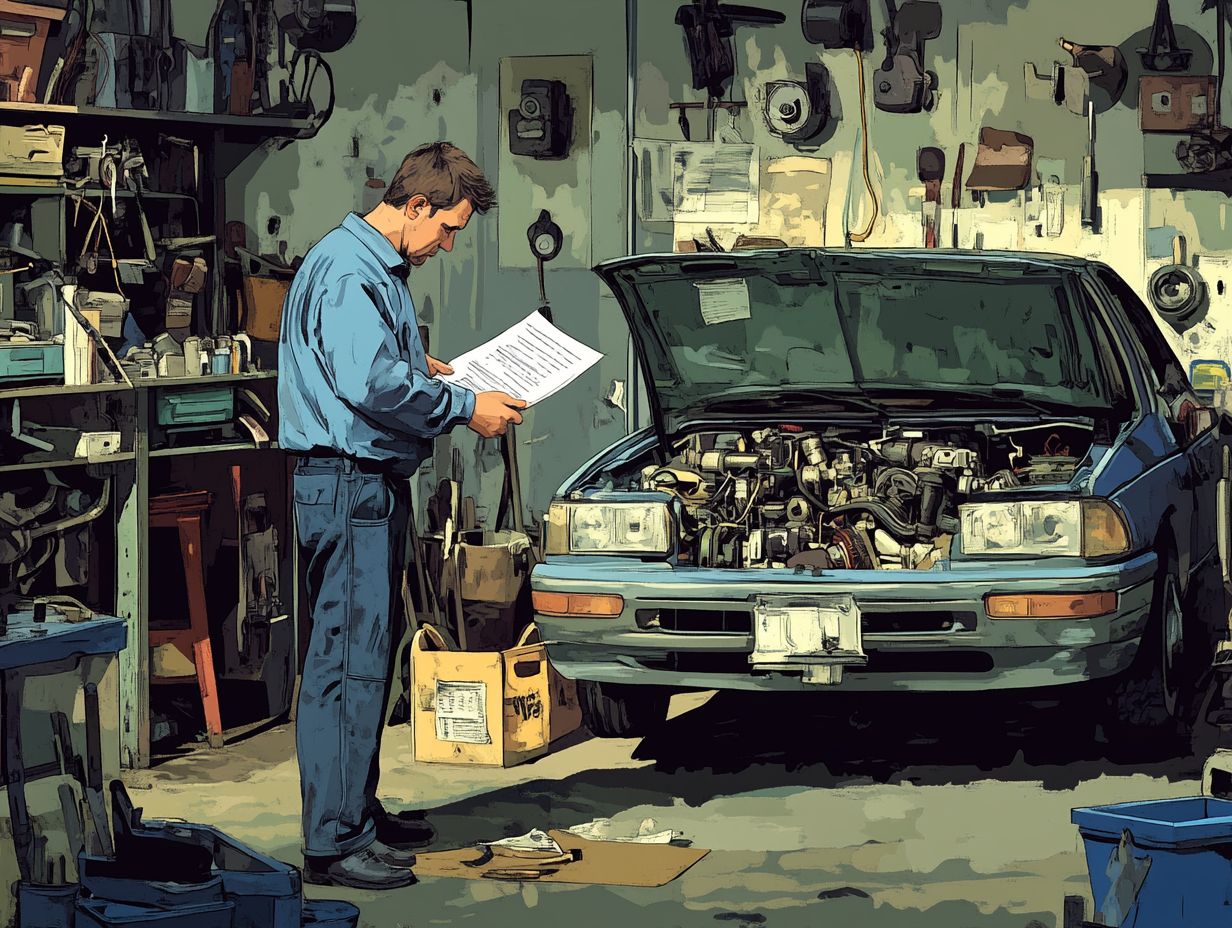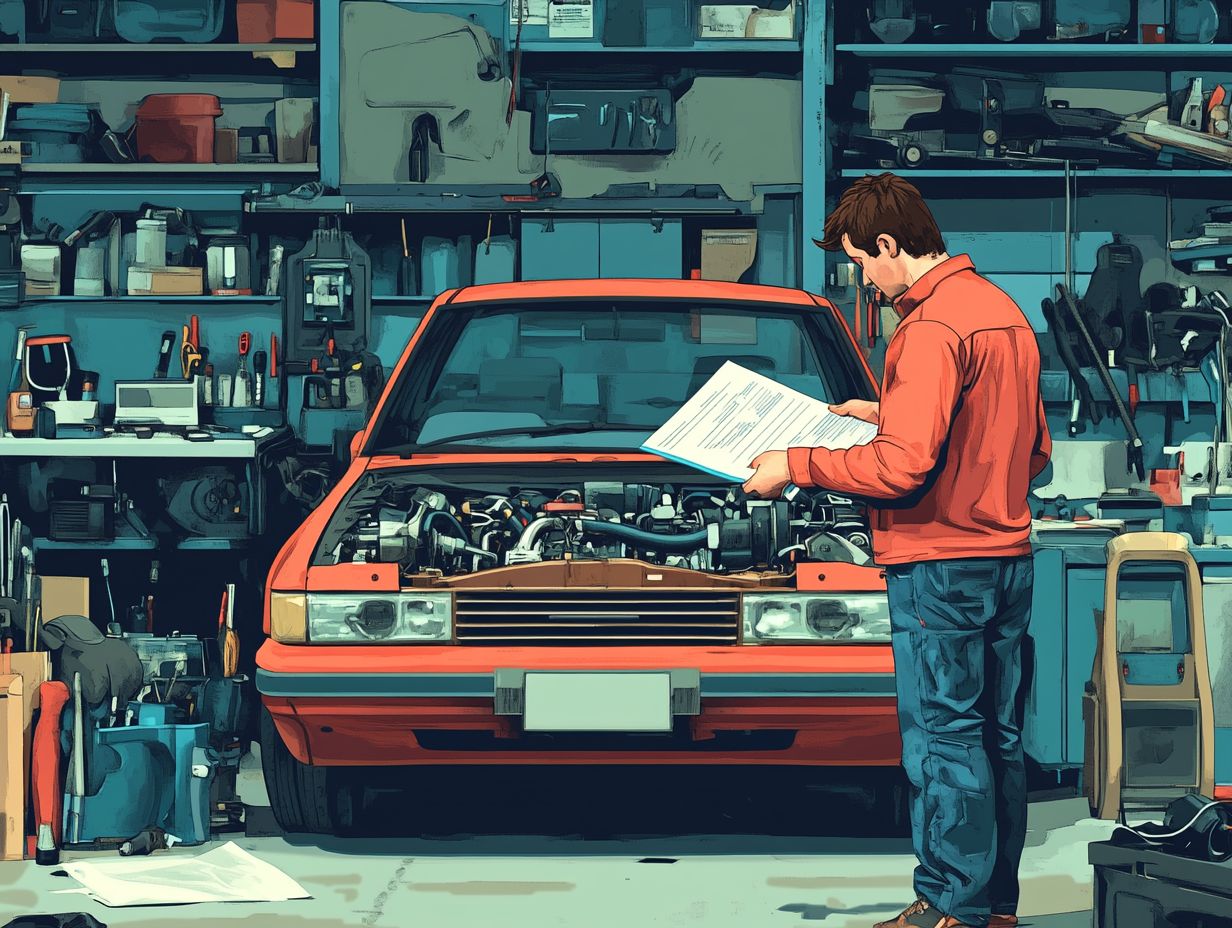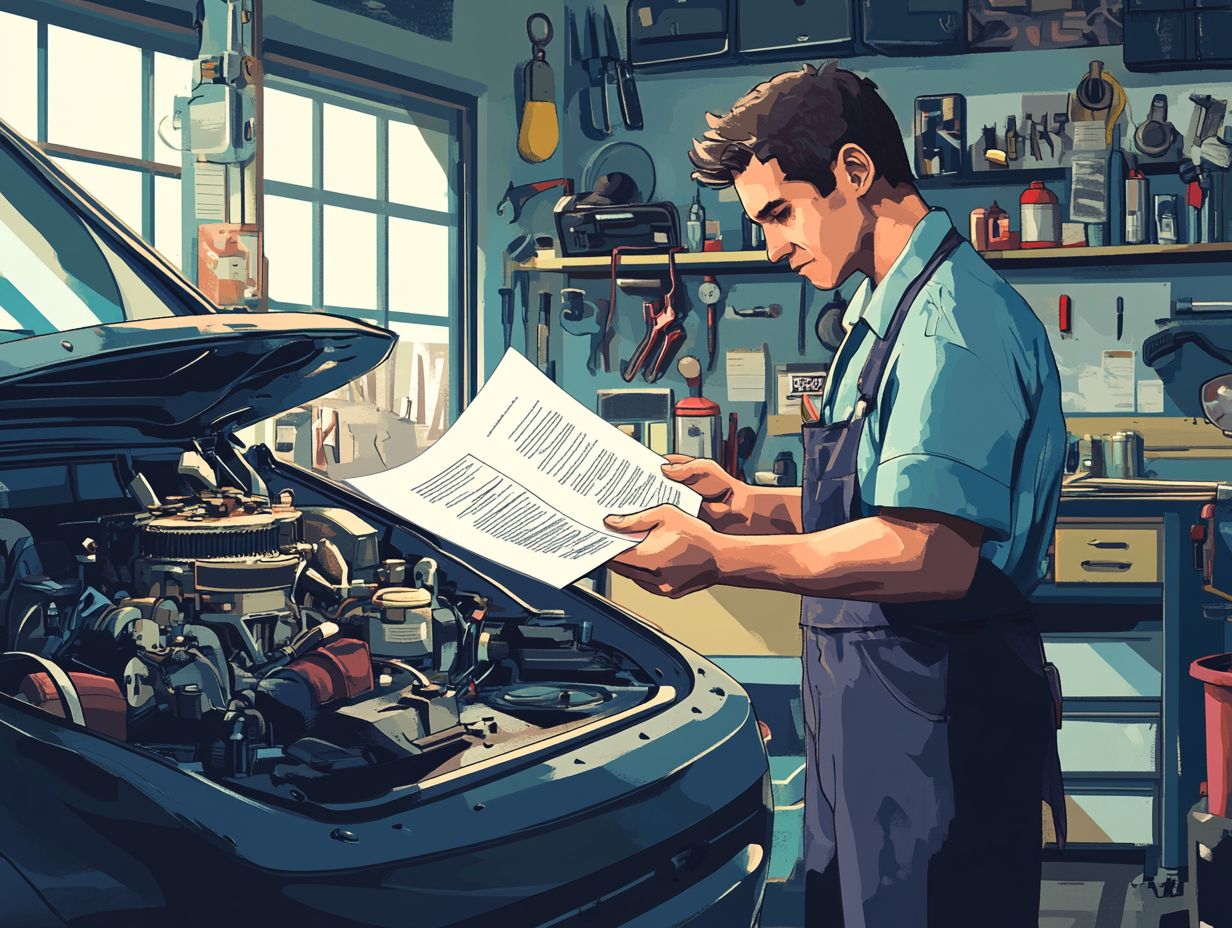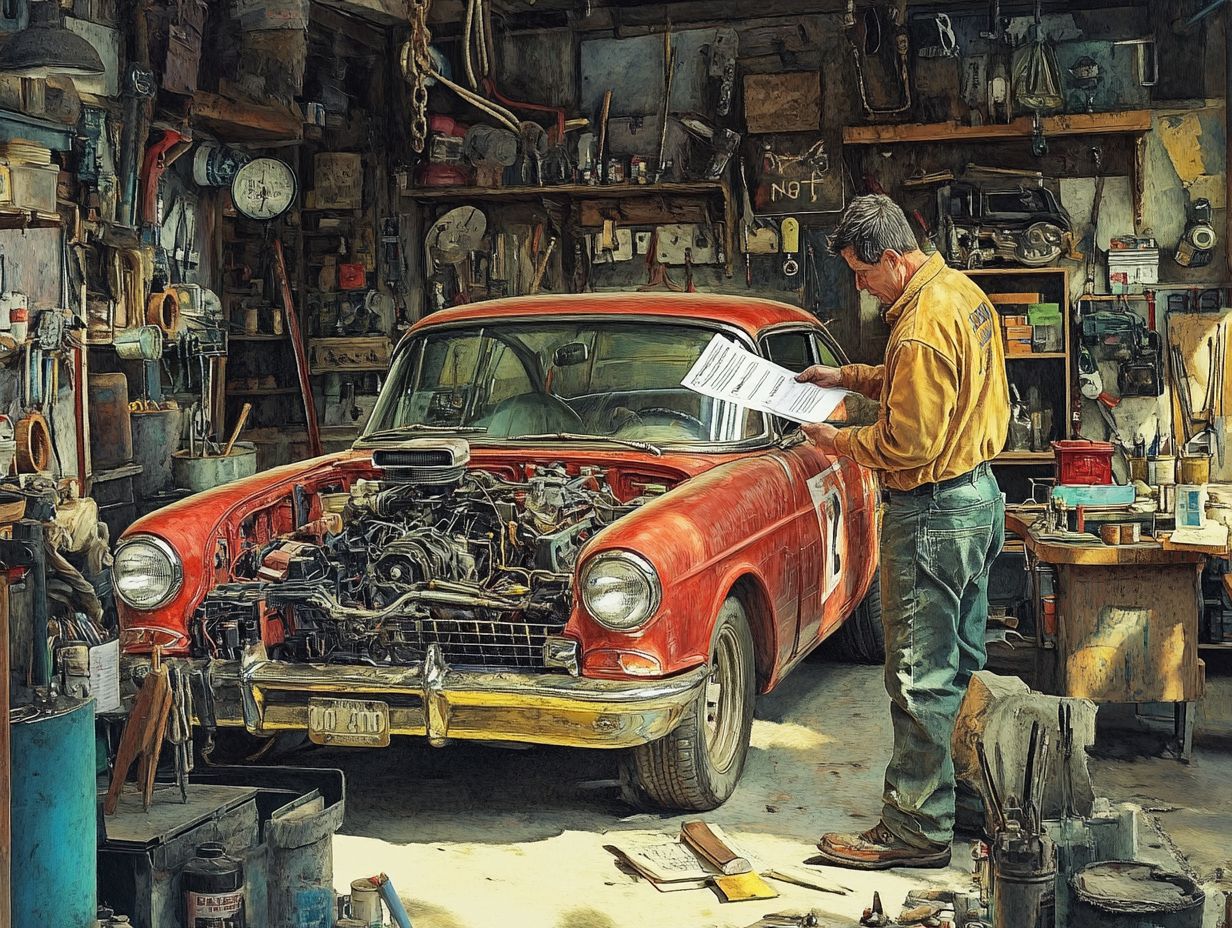What to Know About Powertrain Warranties
Powertrain warranties are essential to your vehicle ownership experience. They provide peace of mind about the major components that keep your car running smoothly.
This article explores the ins and outs of powertrain warranties, guiding you through their definition, coverage, and specific parts they include. It highlights the differences between factory and extended options, helping you consider critical factors before making a purchase.
This article also explains how to make the most of your warranty when you need it. Additionally, it dispels common misconceptions, empowering you to navigate the often complex world of powertrain warranties with confidence.
Contents
- Key Takeaways:
- Understanding Powertrain Warranties
- What is Included in a Powertrain Warranty?
- Types of Powertrain Warranties
- Factors to Consider Before Purchasing a Powertrain Warranty
- How to Use a Powertrain Warranty
- Common Misconceptions About Powertrain Warranties
- Frequently Asked Questions
- What to Know About Powertrain Warranties?
- What does a powertrain warranty cover?
- How long does a powertrain warranty last?
- Is a powertrain warranty the same as a bumper-to-bumper warranty?
- Can I purchase a powertrain warranty for a used car?
- What should I do if I have a problem covered by my powertrain warranty?
Key Takeaways:

- A powertrain warranty covers the heart of your vehicle: the engine, transmission, and drivetrain. This means fewer worries about unexpected repair costs!
- Understand what s covered before you buy. Choose wisely between factory and extended options for the best fit for your needs.
- Not all warranties are the same! Proper maintenance is key to keeping your warranty valid and your car running smoothly.
Understanding Powertrain Warranties
Grasping the nuances of powertrain warranties is crucial for car owners who want solid protection for their new vehicles. A powertrain warranty mainly covers vital parts like the engine and transmission, allowing you to minimize repair costs.
This warranty often comes bundled within a comprehensive warranty package, but you can also purchase it as an extended warranty for added peace of mind.
Definition and Coverage
A powertrain warranty is a specialized automotive warranty that covers key components of your vehicle’s powertrain system, including the engine and transmission.
This warranty provides essential protection, shielding you from the potentially hefty repair costs that can arise from powertrain failures. Typically, it includes components like the drivetrain, which features the driveshaft, differential, and axles, among others.
For vehicle owners like you, having a solid powertrain warranty brings peace of mind and financial security, relieving you of worries related to unexpected repair expenses. By understanding the terms of these warranties, you can make informed decisions about what is covered and the duration of that coverage.
What is Included in a Powertrain Warranty?
A powertrain warranty encompasses essential coverage for critical car components, particularly those within the powertrain system. This system includes the engine, transmission, and other interconnected parts that work together to ensure your vehicle operates at peak efficiency.
Components and Parts Covered
Powertrain warranties typically cover the essential components that keep your vehicle running smoothly, including the engine, transmission, and other important parts crucial for performance.
These warranties often extend to key elements like the driveshaft, differentials, and axles, all of which work in harmony for seamless power delivery and handling. Each component is vital; for instance, the engine serves as the vehicle’s heart, transforming fuel into motion, while the transmission expertly manages that power, enabling smooth gear shifts.
By securing warranty protection for these parts, you can avoid hefty repair bills that may arise from unexpected failures. This coverage not only brings peace of mind but also protects your investment in the vehicle, making it an invaluable aspect of car ownership.
Types of Powertrain Warranties

You ll encounter two main types of powertrain warranties: the factory warranties offered by manufacturers and the extended warranties available for separate purchase. Extended warranties are designed to enhance your coverage options as a car owner.
Understanding powertrain warranties is crucial for making informed decisions about your protection. Evaluate your options carefully to ensure you choose the warranty that best suits your needs.
Factory vs. Extended Warranties
A factory warranty is the initial guarantee that comes with your new vehicle. An extended warranty is an extra layer of protection you can purchase from various providers, extending your coverage beyond the factory period.
Understanding the differences between these two types of coverage is vital for you as a vehicle owner. The factory warranty typically covers a range of manufacturer defects and is valid for a specified duration, often spanning three to five years or a certain mileage limit.
Conversely, an extended warranty extends this coverage, offering you peace of mind for several additional years, although it may come with a higher price tag.
It s essential to assess factors such as coverage limits, which can vary significantly based on the provider and plan, as well as the specific components included.
While factory warranties are generally backed by the vehicle’s manufacturer, extended warranties might originate from third-party providers, each with different reputations and service levels. Therefore, conducting thorough research is necessary to ensure you make an informed decision.
Factors to Consider Before Purchasing a Powertrain Warranty
Before you buy a powertrain warranty, make sure you check out these key factors:
- the cost
- the breadth of coverage
- any potential exclusions that might impact your vehicle’s maintenance and future warranty claims.
Making informed choices in these areas can significantly influence your ownership experience.
Cost, Coverage, and Exclusions
The cost of a powertrain warranty can fluctuate greatly depending on the coverage provided. It s essential for you to fully grasp what is included, as well as any exclusions that may apply.
Understanding these details influences your buying choices. As a potential buyer, you’ll want to consider the financial implications of unforeseen repair costs that could arise if certain issues aren t covered.
It s crucial to examine the warranty’s duration, the specific components included, and any deductibles the amount you pay out of pocket before coverage kicks in that may be required. Ensuring that your investment aligns perfectly with your individual needs is key.
By staying informed about these details, you can make savvy choices that not only enhance your vehicle s longevity but also bring you peace of mind, ultimately leading to a more enjoyable ownership experience.
How to Use a Powertrain Warranty
Understanding how to effectively utilize a powertrain warranty is essential for you as a car owner. It s particularly important to grasp the process of filing warranty claims for necessary vehicle repairs, ensuring that you maintain the protection offered by the warranty.
Steps for Filing a Claim

Filing a claim under a powertrain warranty typically requires you to follow a few essential steps:
- Gather necessary documentation.
- Contact the warranty provider.
- Ensure that your vehicle repairs align with the warranty protection requirements.
To start the process effectively, collect all relevant documents, such as your original warranty agreement, service records, and any repair invoices. This careful compilation of information is crucial, as it helps establish that your vehicle has been properly maintained.
Next, reaching out to the warranty provider is vital. When you do, be prepared to clearly explain the issue you ve experienced. It’s important to confirm that any repairs or services are carried out by an authorized mechanic, as this compliance is key to ensuring coverage under the terms of the warranty.
Common Misconceptions About Powertrain Warranties
You may encounter several common misconceptions about powertrain warranties that can create confusion among car owners. These misunderstandings often revolve around warranty claims, coverage limitations, and exclusions that might not be immediately obvious.
Debunking Myths and Understanding the Truth
Many car owners fall into the trap of thinking that every vehicle repair is covered under their powertrain warranty. However, grasping the nuances of warranty claims and exclusions is essential for making the most of your coverage.
A powertrain warranty protects key parts of your car that help it move, like the engine and transmission. Powertrain warranties primarily safeguard the critical components that keep your vehicle running smoothly, including the engine, transmission, and drivetrain.
It s important to remember that cosmetic damages and routine maintenance costs like oil changes and brake pads are generally not included in this coverage.
Some might assume that any issue with these parts is automatically covered, but that assumption can lead to disappointment, especially if the failure stems from neglect or improper maintenance.
To navigate these complexities, you should familiarize yourself with your specific warranty agreement, allowing you to approach claims with accuracy and confidence.
Frequently Asked Questions
What to Know About Powertrain Warranties?
A powertrain warranty is a type of vehicle warranty that covers the major components of the engine, transmission, and drivetrain. Understanding the details of this warranty can save you from unexpected repair costs.
What does a powertrain warranty cover?

A powertrain warranty typically covers the engine, transmission, drivetrain components, such as the axles, driveshaft, and differential, including the seals and gaskets associated with these parts.
How long does a powertrain warranty last?
The length of a powertrain warranty varies by manufacturer, but it typically lasts for a certain number of years or a certain number of miles, whichever comes first. Always check your warranty details to know exactly how long you’re covered!
Is a powertrain warranty the same as a bumper-to-bumper warranty?
No, a powertrain warranty is not the same as a bumper-to-bumper warranty. A bumper-to-bumper warranty covers almost all components of a vehicle, while a powertrain warranty only covers the major components of the engine, transmission, and drivetrain.
Can I purchase a powertrain warranty for a used car?
Yes, some dealerships and third-party companies offer powertrain warranties for used cars. However, the coverage may vary and may not be as comprehensive as a manufacturer’s warranty for a new car.
What should I do if I have a problem covered by my powertrain warranty?
If your vehicle has an issue that is covered by your powertrain warranty, don t wait! Contact your dealership immediately. They will guide you through the repair process and ensure that the issue is resolved at no cost to you, as long as it falls within the warranty’s coverage terms.




